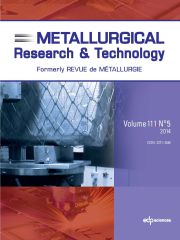Article contents
The behavior of arsenic trioxide in non-ferrous extractivemetallurgical processing
Published online by Cambridge University Press: 14 May 2014
Abstract
Study of the acid bake-leach process has shown potential advantages for the treatment ofenargite (Cu3AsS4) concentrates. Among the most important advantages of theprocess is the transformation of enargite to water-soluble copper sulfate and highlysoluble arsenic trioxide (arsenolite). Because arsenic is retained in the condensed phaseduring the baking, the vapor pressure of arsenic trioxide should be estimated at typicalbaking temperatures (e.g. 473 K). To that end, the vapor pressure of As4O6 (g) was estimated under thebaking conditions based on published thermodynamic values. The vapor pressure ofarsenolite at 473 K was found to be approximately 9.03 × 10-4 atm. Based on thelinear regression analysis of the published vapor pressure values for arsenolite in thetemperature range 366−579 K,the equation for the best fit line was found to be as follows, with a correlationcoefficient of 0.9973:
logPArsenolite(atm) = (-5780.7)/(T (K))+9.16.
Available information on arsenic trioxide does not allow a definite conclusion regardingthe arsenolite/claudetite transformation temperature and their exact melting points.However, the transition temperature has been reported to be in the wide range of240−506 K in differentreferences. Furthermore, the thermodynamic information concerning arsenolite/claudetite issparse and at times not consistent. An effort has been made in this paper to compile themost reliable thermodynamic information for arsenic trioxide (arsenolite and claudetite).
Information
- Type
- Research Article
- Information
- Copyright
- © EDP Sciences 2014
References
- 8
- Cited by

